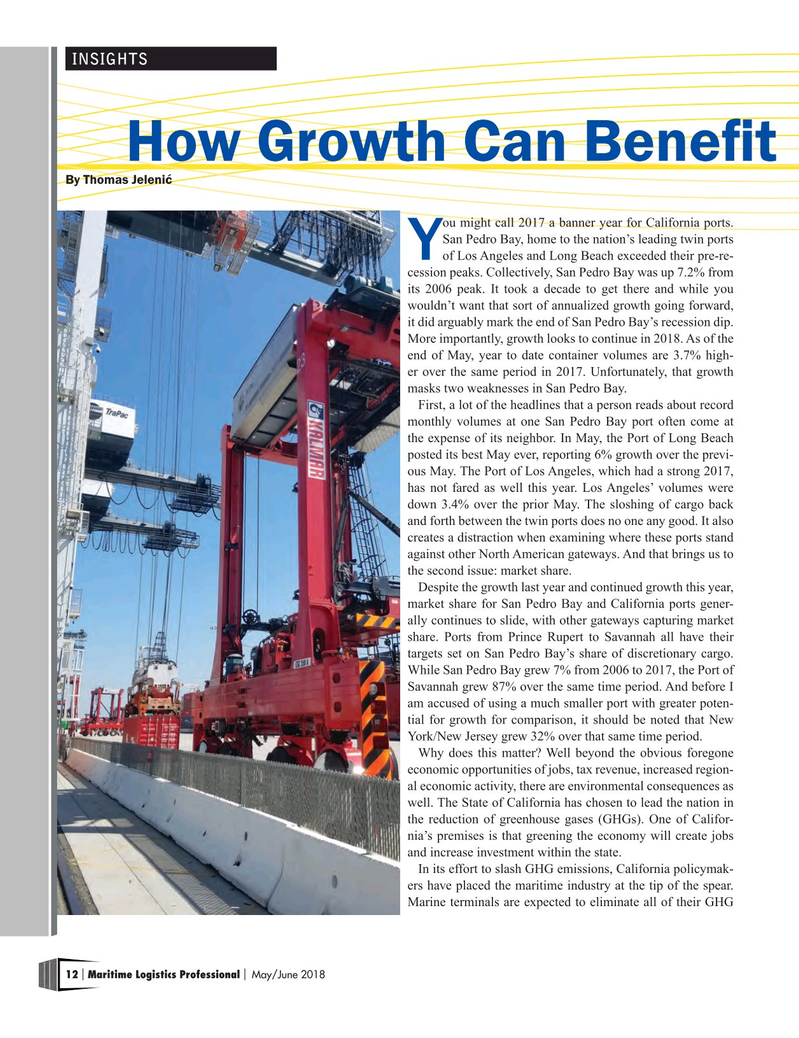
Page 12: of Maritime Logistics Professional Magazine (May/Jun 2018)
Container Ports
Read this page in Pdf, Flash or Html5 edition of May/Jun 2018 Maritime Logistics Professional Magazine
INSIGHTS
How Growth Can Beneft
By Thomas Jelenic ou might call 2017 a banner year for California ports.
San Pedro Bay, home to the nation’s leading twin ports
Yof Los Angeles and Long Beach exceeded their pre-re- cession peaks. Collectively, San Pedro Bay was up 7.2% from its 2006 peak. It took a decade to get there and while you wouldn’t want that sort of annualized growth going forward, it did arguably mark the end of San Pedro Bay’s recession dip.
More importantly, growth looks to continue in 2018. As of the end of May, year to date container volumes are 3.7% high- er over the same period in 2017. Unfortunately, that growth masks two weaknesses in San Pedro Bay.
First, a lot of the headlines that a person reads about record monthly volumes at one San Pedro Bay port often come at the expense of its neighbor. In May, the Port of Long Beach posted its best May ever, reporting 6% growth over the previ- ous May. The Port of Los Angeles, which had a strong 2017, has not fared as well this year. Los Angeles’ volumes were down 3.4% over the prior May. The sloshing of cargo back and forth between the twin ports does no one any good. It also creates a distraction when examining where these ports stand against other North American gateways. And that brings us to the second issue: market share.
Despite the growth last year and continued growth this year, market share for San Pedro Bay and California ports gener- ally continues to slide, with other gateways capturing market share. Ports from Prince Rupert to Savannah all have their targets set on San Pedro Bay’s share of discretionary cargo.
While San Pedro Bay grew 7% from 2006 to 2017, the Port of
Savannah grew 87% over the same time period. And before I am accused of using a much smaller port with greater poten- tial for growth for comparison, it should be noted that New
York/New Jersey grew 32% over that same time period.
Why does this matter? Well beyond the obvious foregone economic opportunities of jobs, tax revenue, increased region- al economic activity, there are environmental consequences as well. The State of California has chosen to lead the nation in the reduction of greenhouse gases (GHGs). One of Califor- nia’s premises is that greening the economy will create jobs and increase investment within the state.
In its effort to slash GHG emissions, California policymak- ers have placed the maritime industry at the tip of the spear.
Marine terminals are expected to eliminate all of their GHG 12 Maritime Logistics Professional May/June 2018 | |

 11
11

 13
13
